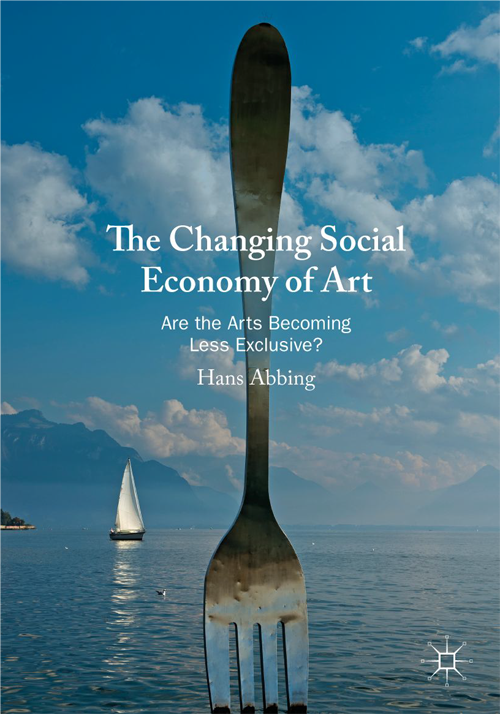
Below I insert the cover text , the Table of Contents of the book and some endorsements. If you want more information visit the book’s website. There you can also find a kind of summary of the book.
www.hansabbing.com
Cover text
Is art for everybody? Why do art lovers attach so much value to authenticity, autonomy and authorship? Why did the arts become so serious in the first place? Why do many artists reject commerce and cultural entrepreneurship? Crucially, are any of the answers to these questions currently changing? Hans Abbing is uniquely placed to answer such questions, and, drawing on his experiences as an economist and sociologist as well as a professional artist, in this volume he addresses them head on. In order to investigate changes in the social economy of the arts, Abbing compares developments in the established arts with those in the popular arts and proceeds to outline key ways that the former can learn from the latter; by lowering the cost of production, fostering innovation, and becoming less exclusive. These assertions are contextualized with analysis of the separation between serious art and entertainment in the nineteenth century, lending credence to the idea that government-supported art worlds have promoted the exclusion of various social groups. Abbing outlines how this is presently changing and why, while the established arts have become less exclusive, they are not yet for everybody.
This volume not only offers an accessible introduction to the basics of art economics and art sociology, it also challenges widely held assumptions from within these disciplines. Ideal reading for artists, policy makers and those working in professional arts education, as well as for researchers, undergraduate and postgraduate students. The use of semi-autobiographical reflections from an artist alter-ego interspersed throughout the text adds much to the accessibility of the work.
Table of Contents
PREFACE
THE TRIUMPH OF SERIOUS ART
A High Respect for Art / Separation of Art and Entertainment / Art-worlds with Authority / Innovative Art and Mainstream Art
AUTHENTIC ART AND ARTISTS
In Search of an “Authentic Self” / An Obsession with Authenticity, Authorship and Aura / Informalization / An Attractive Low-Income Profession
EXCLUSION
Art Not for Everybody and Not by Everybody / Mechanisms of Exclusion / Attempts at Inclusion / A Love of Art and a Love of Exclusivity
DISTRUST OF COMMERCE AND COMMERCIALISM
Hostile Spheres / Disapproval and Covering Up of Commerce / Commercialism and Dependence of Artists and Art-companies on Demand, Sponsorship and Support / Enrichment and Marketing
SHARING ART
Increased sharing / Less Exclusive
CONCLUSION
Endorsements
(1) With this new book Abbing once again taunts the world of the arts for its romantic self-image, confronting it with a sobering reality of commercial and technological innovations which, so he argues, are for the better. A must read for students of the arts. Arjo Klamer, Professor of Cultural Economics at the Erasmus University.
(2) This valuable text evokes Howard Becker’s “Art Worlds”, and likewise it will have strong repercussions in the contemporary triangle of the production, distribution, and consumption of the arts. Whether you agree or disagree with Abbing’s provocative statements, undoubtfully his thoughts about the contemporary power of the economy and sociology of the arts are worth to be discussed. This book is a treasure trove of issues such as consequences of the still ongoing polarity of “serious” and “popular arts”, opportunities for innovation in the arts, the obsession with authenticity and aura, the double-edged sword of commercialism and enrichment, and alternative ways of art sharing and finding new career paths for artists. Volker Kirchberg, Professor Sociology of the Arts, Leuphana University of Lüneburg, Germany.
(3) Just as ‘Why are artists poor’ changed our view on the arts economy, this study will change our view on the social context of the arts. In the 19th century the separation of ‘serious art’ and entertainment coincided with the exclusion of lower social groups. Now the cross-over between art and entertainment along with the claim of inclusion bewilders the cultural gatekeeping elite. Abbing explains why this happens in a book which will be a must-read for many years to come. Joost Heinsius, art theorist and consultant, Amsterdam
(4) A must-read for any artist. So much that puzzled me in the arts becomes understandable. Belonging to a new generation of musicians, I especially like Abbing’s treatment of technological changes affecting artistic developments. Being a music producer of electronic music, I contribute to these developments. But I do not earn much money. (I therefore also make commercial work.) The same applies to many of my colleagues. It is a relief to know about the underlying reasons. Hiroaki Oba, music producer, Berlin and Tokyo.
Illustration: GFC Collection / Alamy Stock Photo